Spatio-Temporal Coordination Analysis of Urban Welfare and Tourism Development in the Yangtze River Delta Region
Abstract
1. Introduction
2. Literature Review
2.1. Research on Urban Welfare
2.2. Research on the Relationship between Regional Tourism and Socioeconomic Development and Ecological Environment
2.3. Research on the Relationship between Urban Welfare and Tourism Development
2.4. Coupled Coordinated Mechanism between Urban Welfare and Tourism Development
2.5. Mechanism of the Effect of the Tourism Industry on Urban Welfare
2.6. Mechanism of the Effect of Urban Welfare on the Tourism Industry
3. Methods and Data Sources
3.1. PVAR Model
3.2. Coupled Coordination Degree Model
3.3. The Evaluation Index System of Urban Welfare and Tourism Development
3.4. Data Source
4. Results
4.1. Temporal Evolutionary Characteristics of Urban Welfare and Tourism Development
4.2. Dynamic Interaction Effects between Urban Welfare and Tourism Development
4.3. Spatial Association Pattern between Urban Welfare and Tourism Development
4.4. Spatio-Temporal Coupled Coordination Pattern between Urban Welfare and Tourism Development
5. Discussion
6. Conclusions and Recommendations
6.1. Conclusions
6.2. Policy Recommendation
Author Contributions
Funding
Data Availability Statement
Conflicts of Interest
References
- Donald, J.T. The “difference between heaven and earth”: Urban–rural disparities in well-being in China. Res. Soc. Stratif. Mobil. 2012, 30, 33–47. [Google Scholar]
- Lu, Q.Q.; Xu, G.J.; Xu, K. Urbanization, business cycleand regional income distribution disparity: An analysis based on panel threshold model. Econ. Probl. 2020, 2, 25–32. [Google Scholar]
- Tang, L.N.; Wan, S.Y. Empirical test of relationship between the level of new urbanization and social security. Stat. Decis. 2022, 38, 62–65. [Google Scholar]
- Ding, L.; Shao, Z.F.; Zhang, H.C.; Xu, C.; Wu, D.W. A comprehensive evaluation of urban sustainable development in China based on the topsis-entropy method. Sustainability 2016, 8, 746. [Google Scholar] [CrossRef]
- Sun, J.Q.; Shi, J.; Shen, B.Y.; Li, S.Q.; Wang, Y.W. Nexus among energy consumption, economic growth, urbanization and carbon emissions: Heterogeneous panel evidence considering China’s regional differences. Sustainability 2018, 10, 2383. [Google Scholar] [CrossRef]
- Liang, X.C. A logical interpretation of the tourism industry to promote social welfare. Tour. Trib. 2019, 34, 3–4. [Google Scholar]
- Shen, J.B.; Xu, T.; Lu, M.M.; Zhai, Y.X. Countermeasures for coping with the impacts of the COVID-19 and the development tendency of the tourist industry in the post-epidemic period. Macroecon. Manag. 2020, 8, 55–60. [Google Scholar]
- Zhou, C.; Feng, X.G.; Tang, R. Analysis and forecast of coupling coordination development among the regional economy-ecological environmental-tourism industry: A case study of provinces along the Yangtze Economic Zone. Econ. Geogr. 2016, 36, 186–193. [Google Scholar]
- Christian, S.; Daniele, L. Investigating students’ eco-misperceptions in applying eco-design methods. J. Clean. Prod. 2022, 342, 130866. [Google Scholar]
- Daly, H.E.; Cobb, J.B. For the Common Good; Boston Beacon: Boston, MA, USA, 1989. [Google Scholar]
- Zhang, W.B.; Guo, Q. China’s sustainable economic welfare measurement and the analysis of its regional differences. J. Manag. 2019, 32, 19–30. [Google Scholar]
- Lu, J.; Chen, Y.; Guo, Z.Y. Social welfare, economic growth, and regional development difference: A coupling analysis based on Chinese Provincial data. Chin. J. Popul. Sci. 2012, 3, 31–43+111. [Google Scholar]
- Amartya, S. Capability and well-being. In The Quality Life; Nussbaum, M., Sen, A., Eds.; Oxford University Press: Oxford, UK, 1993. [Google Scholar]
- Abdallah, S.; Marks, N. The happy planet index. In Encyclopedia of Quality of Life and Well-Being Research; Springer: Dordrecht, The Netherlands, 2014. [Google Scholar]
- Wang, S.Y.; Luo, Y.T.; Han, Y.J.; Li, J. Regional difference and determinants of human well-being in China: Based on the analysis of human development index. Prog. Geogr. 2018, 37, 1150–1158. [Google Scholar]
- Max-Neef, M. Economic growth and quality of life: A threshold hypothesis. Ecol. Econ. 1995, 15, 115–118. [Google Scholar] [CrossRef]
- Armiento, M. The sustainable welfare index: Towards a threshold effect for Italy. Ecol. Econ. 2018, 152, 296–309. [Google Scholar] [CrossRef]
- Mahony, T.; Escardo-Serra, P.; Dufour, J. Revisiting ISEW valuation approaches: The case of Spain including the costs of energy depletion and of climate change. Ecol. Econ. 2018, 144, 292–303. [Google Scholar] [CrossRef]
- Bleys, B. Proposed changes to the index of sustainable economic welfare: An application to Belgium. Ecol. Econ. 2008, 64, 741–751. [Google Scholar] [CrossRef]
- Yuan, Y.; Zhang, W.B.; Jiao, B. Study on the measurement of sustainable economic welfare and threshold effect in China Province. J. Stat. Inf. 2021, 36, 23–34. [Google Scholar]
- Zhuang, R.L.; Mi, K.N.; Chen, Y.; Zhao, B. Temporal-spatial difference of coupling and coordination of social welfare and economic growth in the Yangtze River Delta. Resour. Environ. Yangtze River Basin 2017, 26, 171–179. [Google Scholar]
- He, J.; Chen, J.M.; Wan, H.Y. Demographic structure, economic growth and China’s social welfare level. J. Northeast. Univ. 2018, 20, 19–26. [Google Scholar]
- Zhang, M.; Zou, X.R.; Sha, L. Social security and sustainable economic growth: Based on the perspective of human capital. Sustainability 2019, 11, 662. [Google Scholar] [CrossRef]
- Vinodh, K.N.; Muhammad, A.U.H.; Jayendira, P.S. Causality between public expenditure and economic growth in the Kingdom of Bahrain. Middle East J. Manag. 2022, 9, 209–225. [Google Scholar]
- Pan, S.N.; Li, B.W.; Nie, H.G. Research on the interactive relationship between ecological welfare and economic development: Based on the concept of sustainable development. Sci. Technol. Manag. Res. 2020, 40, 237–244. [Google Scholar]
- Xu, Y.; Yu, J.J.; Yang, C. The temporal and spatial differentiation and driving factors of urban green development welfare in Yangtze River Delta Region. J. Jiangxi Norm. Univ. 2022, 46, 180–189. [Google Scholar]
- Liu, H.H.; Xiao, Y.; Wang, B.; Wu, D.T. Effects of tourism development on economic growth: An empirical study of China based on both static and dynamic spatial Durbin models. Tour. Econ. 2022, 28, 1888–1913. [Google Scholar] [CrossRef]
- Faber, B.; Gaubert, C. Tourism and economic development: Evidence from Mexico’s coastline. Am. Econ. Rev. 2019, 109, 2245–2293. [Google Scholar] [CrossRef]
- Sokhanvar, A.; Çiftçioğlu, S.; Javid, E. Another look at tourism-economic development nexus. Tour. Manag. Perspect. 2018, 26, 97–106. [Google Scholar] [CrossRef]
- Dogru, T.; Bulut, U. Is tourism an engine for economic recovery? Theory and empirical evidence. Tour. Manag. 2018, 67, 425–434. [Google Scholar] [CrossRef]
- Isik, C.; Dogan, E.; Ongan, S. Analyzing the tourism-energy-growth nexus for the top 10 most-visited countries. Economics 2017, 5, 40. [Google Scholar]
- Wall, G.; Wright, C. The Environment Impact of Outdoor Recreation; University of Waterloo: Ontario, ON, Canada, 1977. [Google Scholar]
- Joye, J.F. Tourism development and adaptation to climate change through legal constraint. Worldw. Hosp. Tour. Themes 2018, 10, 244–252. [Google Scholar] [CrossRef]
- Wang, Z.F.; Li, J.Y. Verify and study the coupling coordination development and the interactive stress between tourism and eco-environment in the Yellow River Basin. Resour. Environ. Yangtze River Basin 2022, 31, 447–460. [Google Scholar]
- Hu, Q.S.; He, X.R.; Guo, H. Coupling coordination between an urban tourism and ecological environment system in Changsha City. J. Nat. Sci. Hum. Norm. Univ. 2018, 41, 9–15. [Google Scholar]
- Liu, Y.Z.; Hu, Z.Y. Research on the coordination of tourism development and protection coupling of ecological environment based on PSR model: The empirical evidence from Guizhou Province. Ecol. Econ. 2020, 36, 132–136. [Google Scholar]
- Tang, W.; Zhou, T.C.; Sun, J.; Li, Y.R.; Li, W.P. Accelerated urban expansion in Lhasa City and the implications for sustainable development in a plateau city. Sustainability 2017, 9, 1499. [Google Scholar] [CrossRef]
- Zhao, L.; Dong, Y.F. Tourism agglomeration and urbanization: Empirical evidence from China. Asia Pac. J. Tour. Res. 2017, 22, 512–523. [Google Scholar] [CrossRef]
- Wang, K.; Huang, Z.F.; Yu, F.L.; Cao, F.D. Spatial effects of China’s urbanization on tourism economic development: Empirical research based on the spatial panel econometric model. Tour. Trib. 2016, 31, 15–25. [Google Scholar]
- Yang, Z.Q. Study on the mechanism of synergistic development between tourism and new urbanization. Soc. Sci. 2018, 10, 85–90. [Google Scholar]
- Xie, N. Coupling of urbanization and the development of the marine tourism industry: An exploratory study. J. Coast. Res. 2020, 106, 213–216. [Google Scholar] [CrossRef]
- Zhang, F.T.; Sarker, M.N.I.; Lv, Y. Coupling coordination of the regional economy, tourism industry, and the ecological environment: Evidence from western China. Sustainability 2022, 14, 1654. [Google Scholar] [CrossRef]
- Liu, J.S.; Li, C.; Tao, J.Q.; Ma, Y.F.; Wen, X.J. Spatio-temporal coupling factors and mode of tourism industry of tourism industry, urbanization and ecological environment: A case study of Shanxi, China. Sustainability 2019, 11, 4923. [Google Scholar] [CrossRef]
- Xie, X.; Sun, H.; Gao, J.; Chen, F.F.; Zhou, C.S. Spatio-temporal differentiation of coupling and coordination relationship of tourism-urbanization-ecological environment system in China’s major tourist cities. Sustainability 2021, 13, 5867. [Google Scholar] [CrossRef]
- Weng, G.M.; Tang, Y.B.; Pan, Y.; Mao, Y.Q. Spatio-temporal evolution and spatial difference of tourism-ecology-urbanization coupling coordination in Beijing-Tianjin-Hebei urban agglomeration. Econ. Geogr. 2021, 41, 196–204. [Google Scholar]
- Liu, D.G.; Wang, C.J.; Liu, L. Recognition and feelings of rural household towards tourism development in ethic areas: A case study on Dong villages in Zhaoxing, Guizhou. Guizhou Soc. Sci. 2019, 5, 88–93. [Google Scholar]
- Urtasun, A.; Gutie’rrez, L. Tourism agglomeration and its impact on social welfare: An empirical approach to the Spanish case. Tour. Manag. 2005, 27, 901–912. [Google Scholar] [CrossRef]
- Tokarchuk, O.; Gabriele, R.; Maurer, O. Development of city tourism and well-being of urban residents: A case of German magic cities. Tour. Econ. 2017, 23, 343–359. [Google Scholar] [CrossRef]
- Choudhary, P.; Amit, G. Impact of tourism development (TD) on Non-Material Well-Being (NMWB) of residents of Chittorgarh, Rajasthan. J. Tour. Intell. Smartness 2019, 2, 14–26. [Google Scholar]
- Kyungmi, K.; Muzaffer, U.; Joseph, M.S. How does tourism in a community impact the quality of life of community residents? Tour. Manag. 2013, 36, 527–540. [Google Scholar]
- Hjalagar, A. Innovation in tourism from a welfare state perspective Scandinavian. Scand. J. Hosp. Tour. 2005, 5, 46–62. [Google Scholar] [CrossRef]
- Khan, A.; Bibi, S.; Lyu, J.Y.; Alam, M.; Khan, M.M.; Nurunnabi, M. The quest of tourism and overall well-being: The developing economy of Pakistan. PSU Res. Rev. 2021, 5, 120–140. [Google Scholar] [CrossRef]
- Raymond, C.; Brown, G. A spatial method for assessing resident and visitor attitudes towards tourism growth and development. J. Sustain. Tour. 2007, 15, 520–540. [Google Scholar] [CrossRef]
- Zha, J.P.; Tan, T.; Li, Y.Y.; He, L.M. A decomposition analysis on the tourist industrial linkage in China: An empirical research based on input-output analysis. J. Shanxi Univ. Financ. Econ. 2018, 40, 62–74. [Google Scholar]
- Bushell, R.; Sheldon, P.J. Wellness and Tourism: Mind, Body, Spirit, Place; Cognizant Communication Corporation: New York, NY, USA, 2009. [Google Scholar]
- Hartwell, H.; Fyall, A.; Willis, C.; Page, S.; Ladkin, A.; Hemingway, A. Progress in tourism and destination wellbeing research. Curr. Issues Tour. 2018, 21, 1830–1892. [Google Scholar] [CrossRef]
- Dolnicar, S.; Yanamandram, V.; Cliff, K. The contribution of vacations to quality of life. Ann. Tour. Res. 2011, 39, 59–83. [Google Scholar] [CrossRef]
- Shu, X.L.; Gao, Y.B.; Zhang, Y.X.; Yang, C.Y. Study on the coupling relationship and coordinative development between industry and eco-civilization city. China Popul. Resour. Environ. 2015, 25, 82–90. [Google Scholar]
- Shi, P.F.; Li, X.M.; Xiong, Y.B. Coupling measurement and prospect forecast of regional “Beautiful China” construction and tourism industry development: A case study of 11 provinces along the Yangtze River Economic Belt. China Soft Sci. 2018, 2, 86–102. [Google Scholar]
- Hu, Y.; Zheng, J.Y. Is green credit a good tool to achieve “double Carbon” goal? Based on coupling coordination model and PVAR model. Sustainability 2021, 13, 14074. [Google Scholar] [CrossRef]
- Li, Z.J.; Hu, M.J.; Zhang, A.P.; Zhou, N.X. Influence and spillover effect of industrial eco-efficiency on PM2.5 pollution. J. Nat. Resour. 2021, 36, 737–751. [Google Scholar] [CrossRef]
- Xing, L.; Xue, M.G.; Hu, M.S. Dynamic simulation and assessment of the coupling coordination degree of the economy-resource-environment system: Case of Wuhan City in China. J. Environ. Manag. 2019, 230, 470–487. [Google Scholar] [CrossRef] [PubMed]
- Shi, T.; Yang, S.Y.; Zhang, W.; Zhou, Q. Coupling coordination degree measurement and spatio-temporal heterogeneity between economic development and ecological environment: Empirical evidence from tropical and subtropical regions of China. J. Clean. Prod. 2020, 244, 118739. [Google Scholar] [CrossRef]
- Wang, S.J.; Kong, W.; Ren, L.; Zhi, D.D.; Dai, B.T. Research on misuses and modification of coupling coordination degree model in China. J. Nat. Resour. 2021, 36, 793–810. [Google Scholar] [CrossRef]
- Liao, Z.B. Quantitative judgement and classification system for coordinated development of environment and economy: A case study of the city group in the Pearl River Delta. Trop. Geogr. 1999, 2, 76–82. [Google Scholar]
- Jackso, P. Welfare Economic, in What’s New in Economics? Maloney, J., Ed.; Manchester University Press: Manchester, UK, 1992. [Google Scholar]
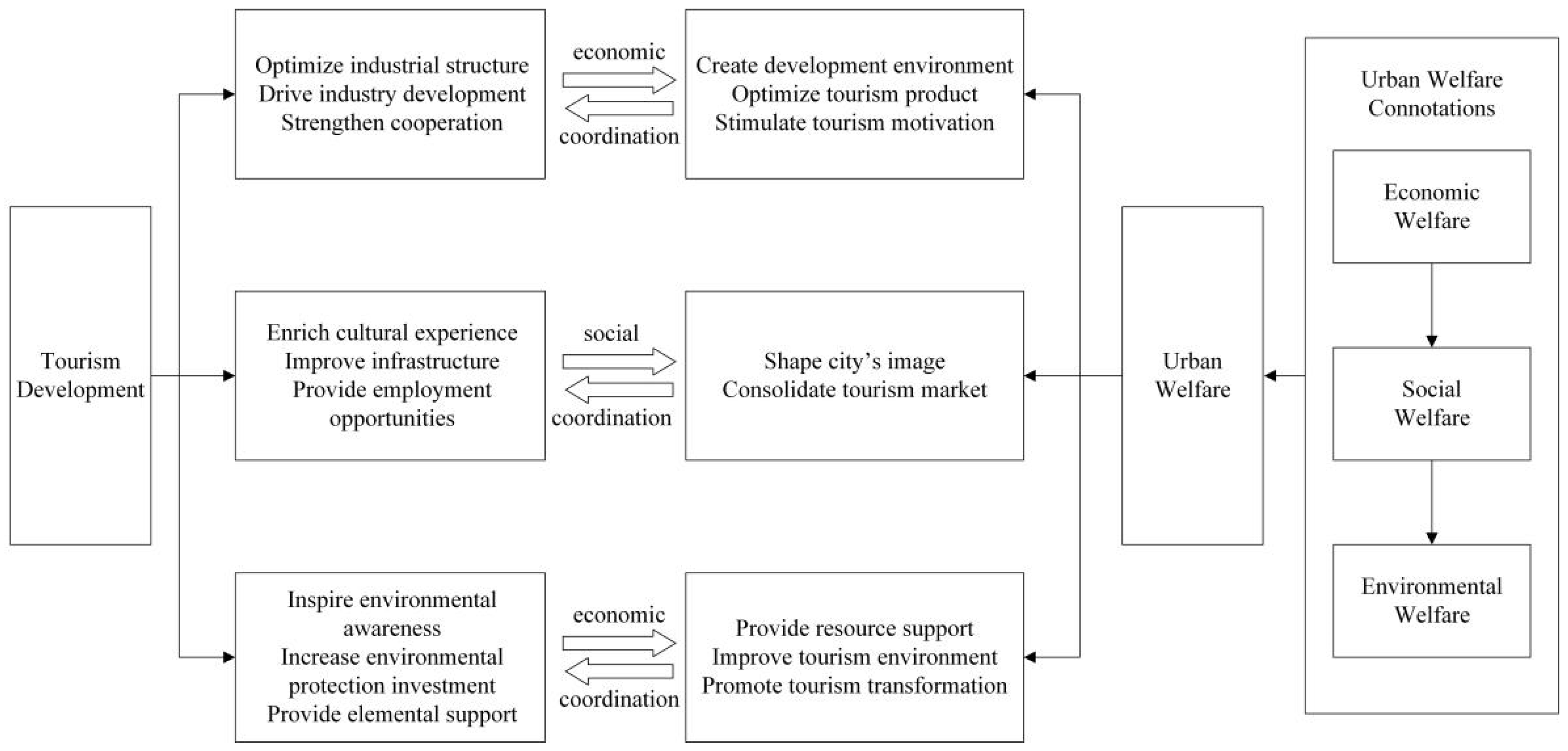
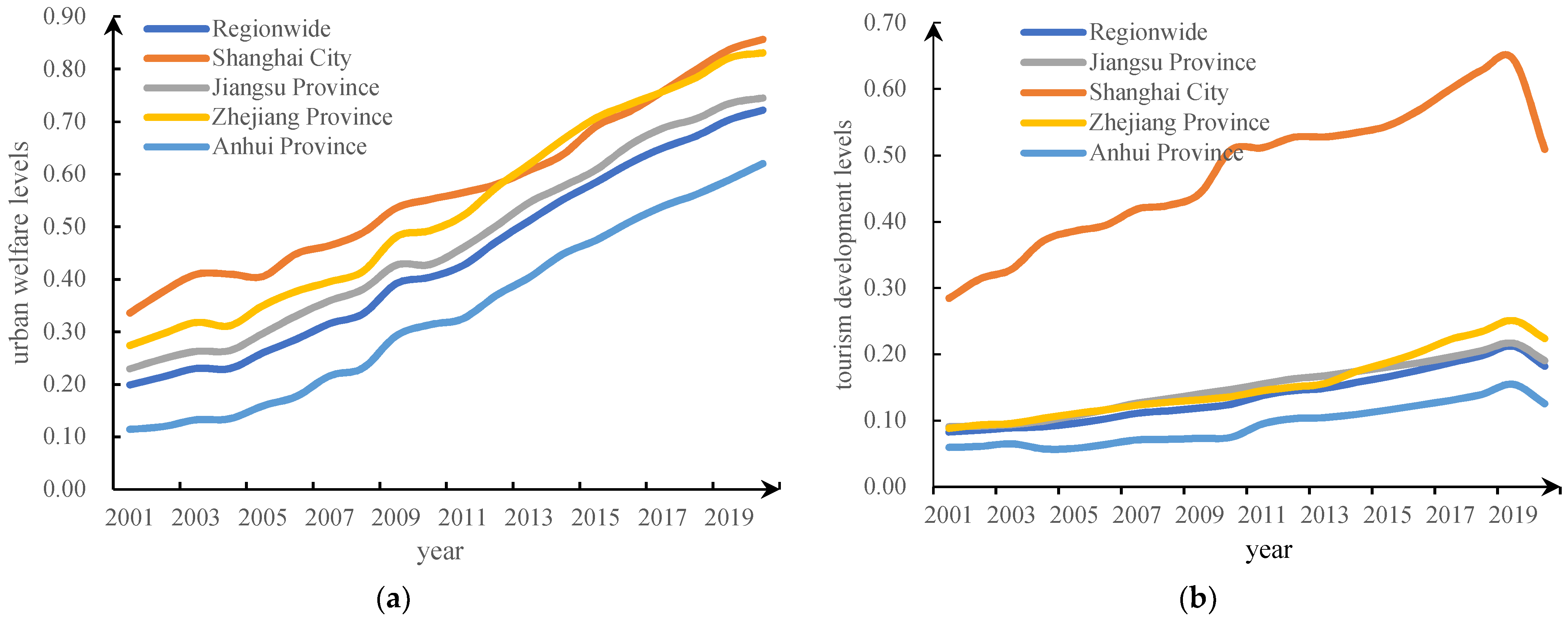
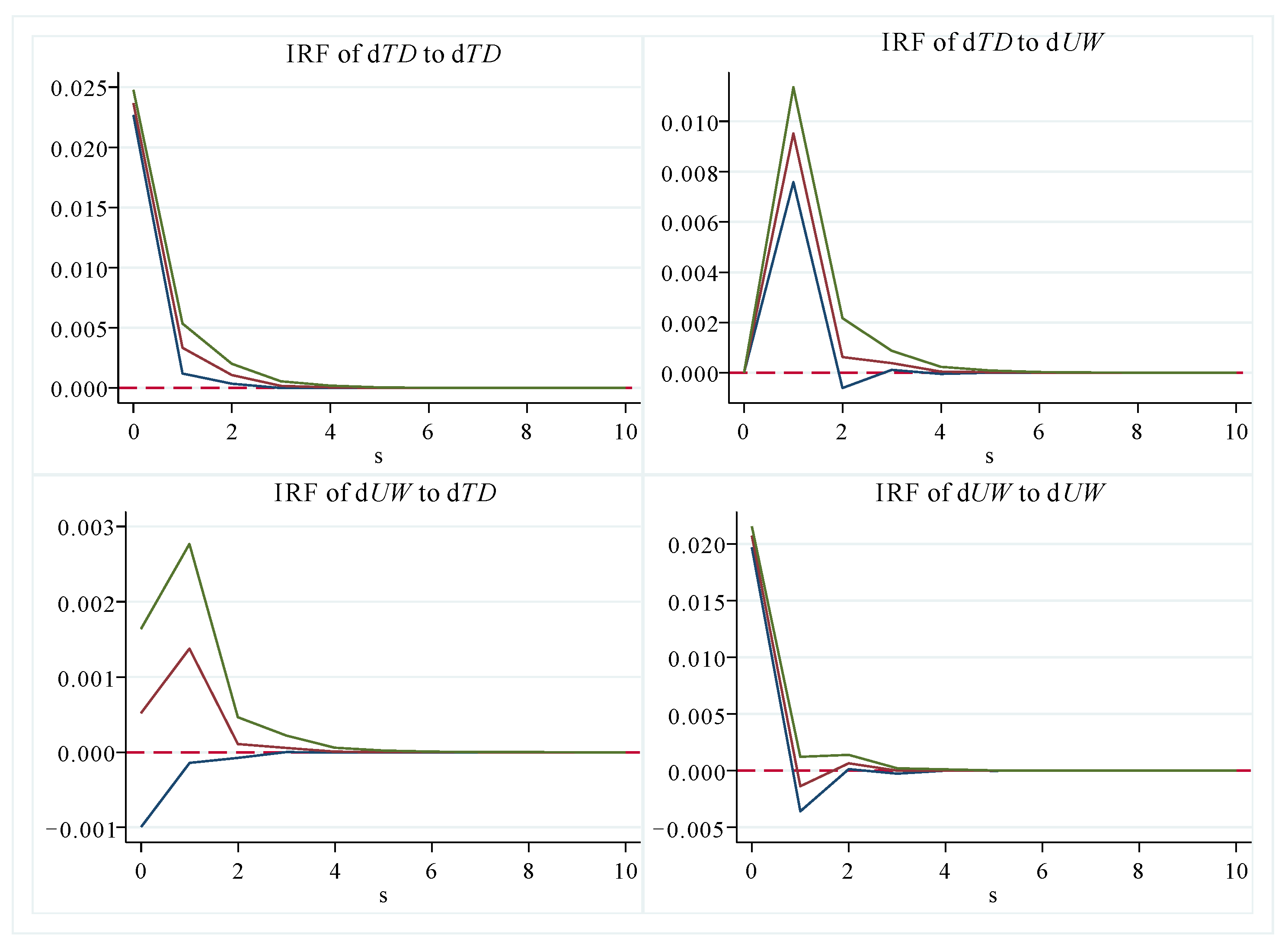
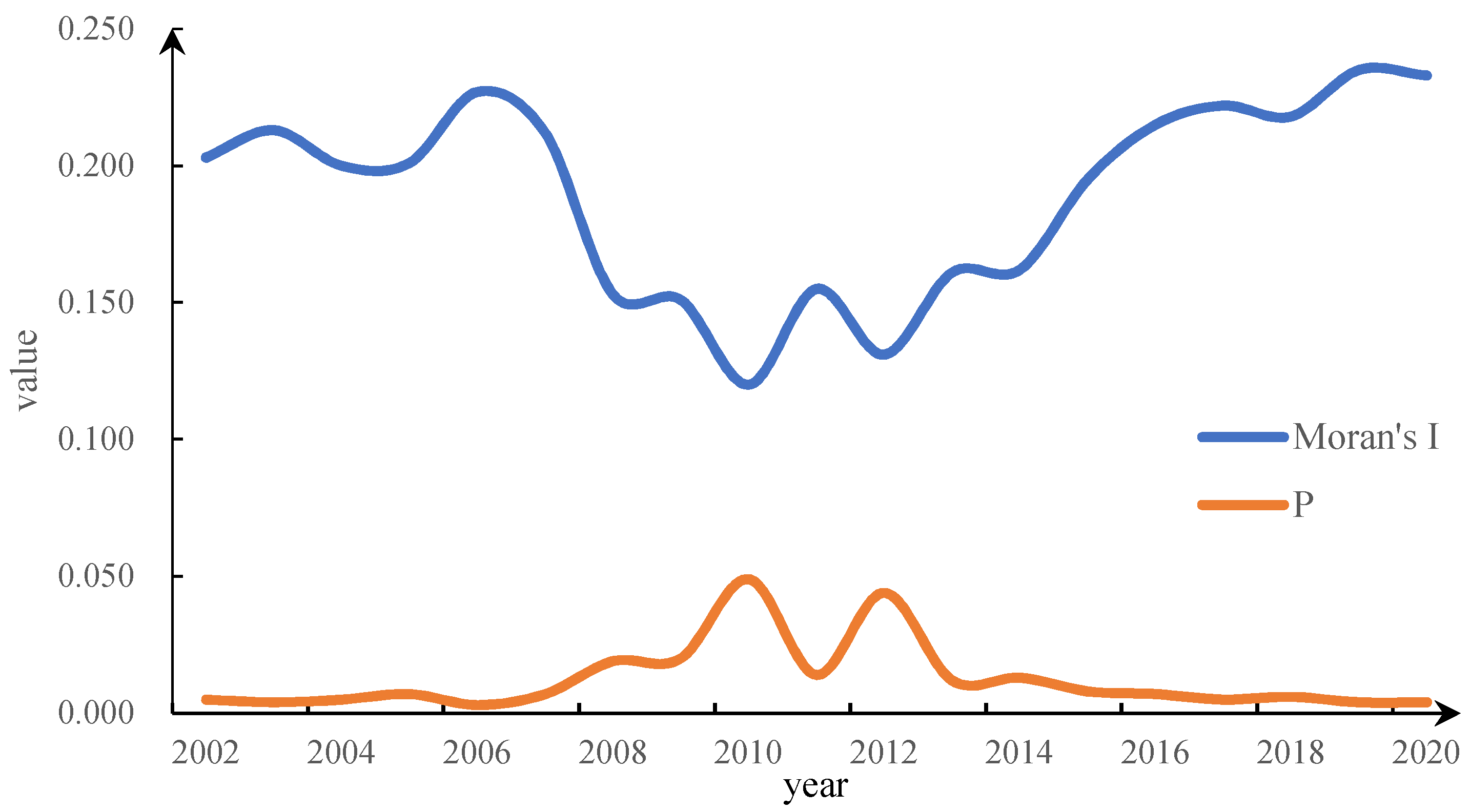

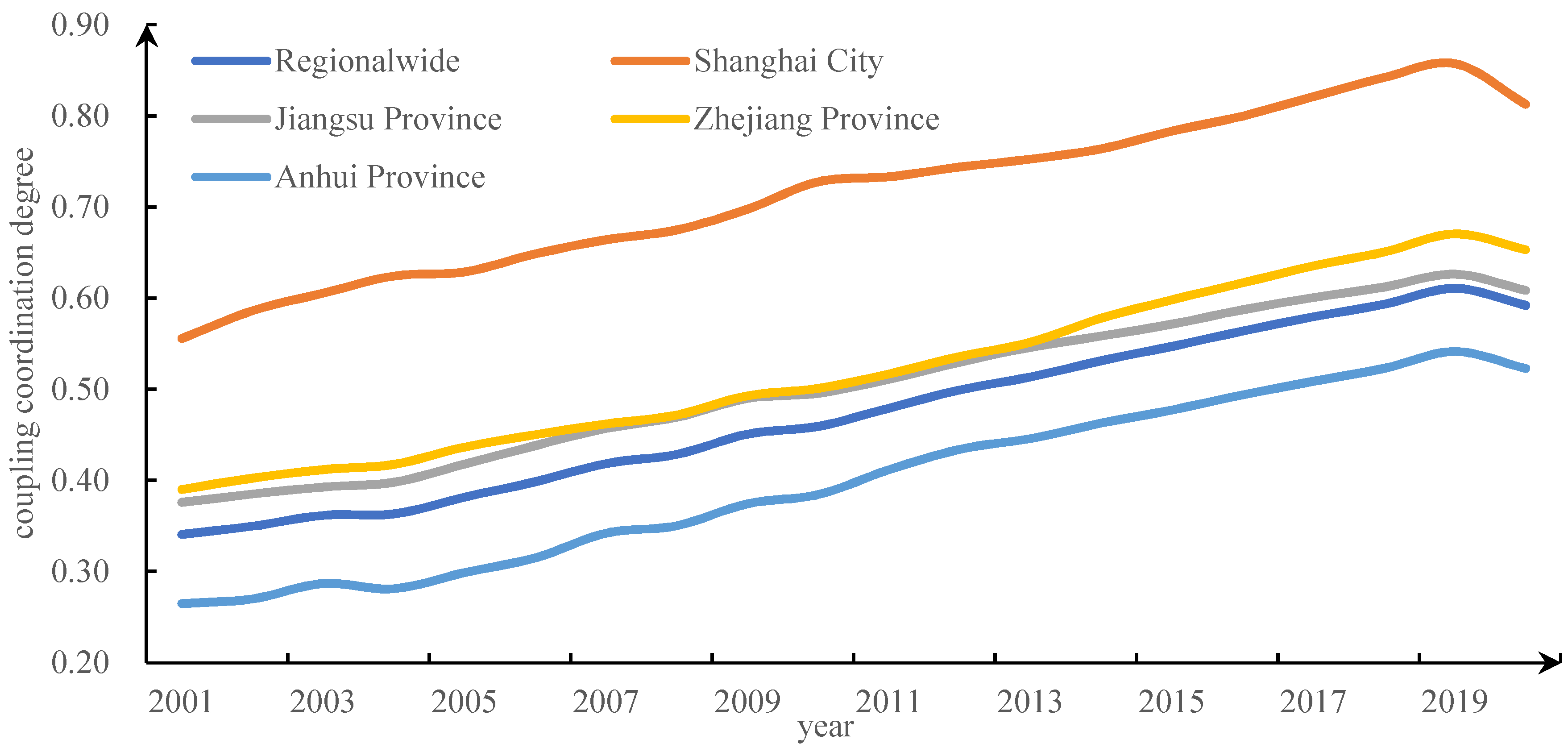
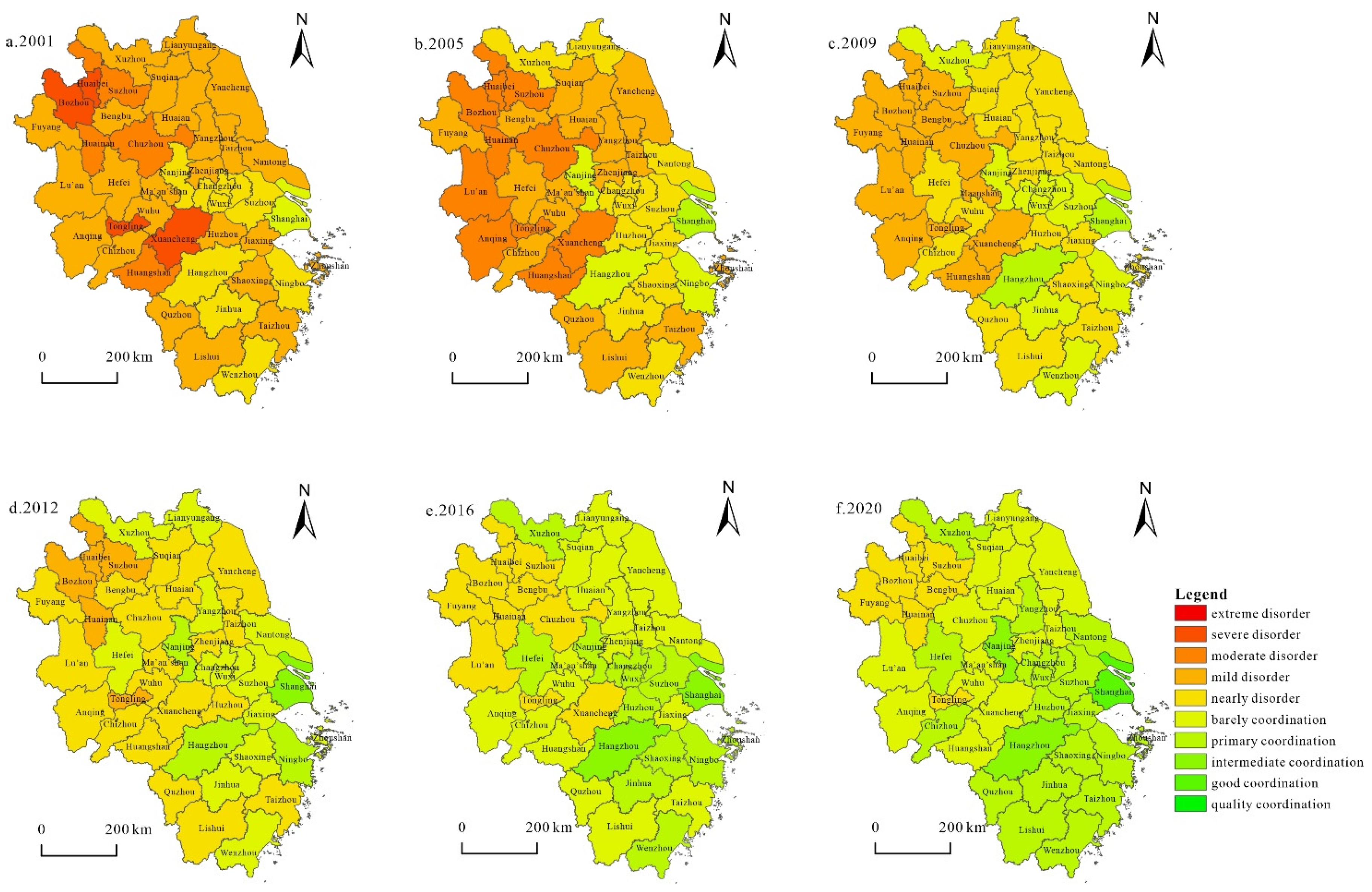
| Rank | Coupled Coordination Value | Coupled Coordination Type | Rank | Coupled Coordination Value | Coupled Coordination Type |
|---|---|---|---|---|---|
| 1 | [0, 0.1) | extreme disorder | 6 | [0.5, 0.6) | barely coordinated |
| 2 | [0.1, 0.2) | severe disorder | 7 | [0.6, 0.7) | primary coordination |
| 3 | [0.2, 0.3) | moderate disorder | 8 | [0.7, 0.8) | intermediate coordination |
| 4 | [0.3, 0.4) | mild disorder | 9 | [0.8, 0.9) | good coordination |
| 5 | [0.4, 0.5) | near disorder | 10 | [0.9, 1] | quality coordination |
| Target Level | Guideline Level | Index Level |
|---|---|---|
| The development level of urban welfare (UW) | Economic Welfare | GDP per capita (Y1), urban disposable income per capita (Y2), rural disposable income per capita(Y3), financial income per capita (Y4), fixed asset investment per capita (Y5), average wage of employees (Y6), savings per capita (Y7), urban per capita consumption (Y8), rural per capita consumption (Y9), Engel’s coefficient for urban residents * (Y10), Engel’s coefficient for rural residents * (Y11), consumer price index * (Y12), residence price index * (Y13), fixed investment as a proportion of GDP (Y14) |
| Social Welfare | growth rate of health investment (Y15), number of doctors per 10,000 people (Y16), number of hospitals per 10,000 people (Y17), number of hospital beds per 10,000 people (Y18), average years of education (Y19), social literacy rate (Y20), basic medical coverage (Y21), minimum subsistence rate (Y22), social employment rate (Y23), urban registered unemployment rate * (Y24), roads per capita (Y25), buses per 10,000 people (Y26), housing floor area per urban dweller (Y27), housing floor area per rural dweller (Y28), Internet penetration rate (Y29), public toilets per 10,000 people (Y30), share of financial expenditure on social public services (Y31), number of libraries per 10,000 people (Y32) | |
| Environmental Welfare | greenery coverage of built-up areas (Y33), green space per capita (Y34), forest coverage (Y35), number of parks per 10,000 people (Y36), air quality excellence rate (Y37), percentage of investment in environmental pollution control (Y38), industrial wastewater discharge compliance rate (Y39), integrated utilization rate of industrial soild waste (Y40), harmless disposal rate of domestic waste (Y41), urban water conservation reuse rate (Y42) | |
| The development level of tourism (TD) | Tourism Industry Scale | number of star-rated hotels (X1), number of scenic spots above Grade 3A (X2), number of travel agents (X3), tertiary sector employees (X4) |
| Tourism Market Size | inbound tourism arrivals (X5), domestic tourism arrivals (X6) | |
| Tourism Industry Economy | foreign exchange earnings from tourism (X7), domestic tourism receipts (X8), tourism revenue as a percentage of GDP (X9), destination tourism per capita (X10), domestic tourism spending per capita (X11), inbound tourism spending per capita (X12) |
| Testing Methods | LLC Test | IPS Test | ADF-Fisher Test | HT Test | Conclusion | ||||
|---|---|---|---|---|---|---|---|---|---|
| Z-Value | p-Value | Z-Value | p-Value | Z-Value | p-Value | Z-Value | p-Value | ||
| UW | −3.393 | 0.000 | −5.252 | 0.000 | −0.118 | 0.453 | −1.763 | 0.039 | unstable |
| dUW | −11.327 | 0.000 | −14.467 | 0.000 | −13.442 | 0.000 | −21.310 | 0.000 | stable |
| TD | 0.888 | 0.813 | −1.116 | 0.132 | 3.192 | 0.999 | −2.698 | 0.004 | unstable |
| dTD | −0.232 | 0.000 | −11.176 | 0.000 | −6.059 | 0.000 | −24.330 | 0.000 | stable |
| Statistic | Value | Z-Value | p-Value |
|---|---|---|---|
| Gt | −2.311 | −8.216 | 0.000 |
| Ga | −15.836 | −16.941 | 0.000 |
| Pt | −12.820 | −8.183 | 0.000 |
| Pa | −16.194 | −33.545 | 0.000 |
| Equation | Chi2 | Prob > Chi2 | Conclusion |
|---|---|---|---|
| UW is not TD’s Granger cause | 38.274 | 0.000 | Rejection *** |
| TD is not UW’s Granger cause | 3.117 | 0.077 | Rejection * |
Publisher’s Note: MDPI stays neutral with regard to jurisdictional claims in published maps and institutional affiliations. |
© 2022 by the authors. Licensee MDPI, Basel, Switzerland. This article is an open access article distributed under the terms and conditions of the Creative Commons Attribution (CC BY) license (https://creativecommons.org/licenses/by/4.0/).
Share and Cite
Wang, C.; Ma, Y.; Zhang, A.; Hu, M. Spatio-Temporal Coordination Analysis of Urban Welfare and Tourism Development in the Yangtze River Delta Region. Systems 2022, 10, 222. https://doi.org/10.3390/systems10060222
Wang C, Ma Y, Zhang A, Hu M. Spatio-Temporal Coordination Analysis of Urban Welfare and Tourism Development in the Yangtze River Delta Region. Systems. 2022; 10(6):222. https://doi.org/10.3390/systems10060222
Chicago/Turabian StyleWang, Chenhong, Yijiao Ma, Aiping Zhang, and Meijuan Hu. 2022. "Spatio-Temporal Coordination Analysis of Urban Welfare and Tourism Development in the Yangtze River Delta Region" Systems 10, no. 6: 222. https://doi.org/10.3390/systems10060222
APA StyleWang, C., Ma, Y., Zhang, A., & Hu, M. (2022). Spatio-Temporal Coordination Analysis of Urban Welfare and Tourism Development in the Yangtze River Delta Region. Systems, 10(6), 222. https://doi.org/10.3390/systems10060222






